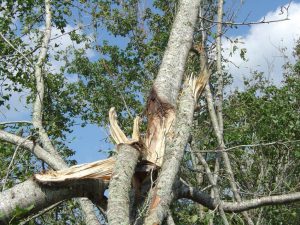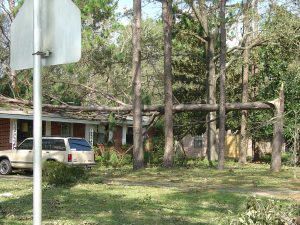The 2020 Atlantic Hurricane Season got off to an early start with some tropical storm activity before the season’s official June 1 start date. We live in a high wind climate. Even our thunderstorms can produce fifty-plus mile per hour winds.
Preventive tree maintenance is key to preparing for storms and high winds.
Falling trees and flying landscape debris during a storm can cause damage. Evaluate your landscape for potential tree hazards. Pruning or removing trees once a hurricane watch has been announced is risky and tree trimming debris left along the street is hazardous.
Now is a good time to remove dead or dying trees, prune decayed or dead branches and stake newly planted trees. Also inspect your trees for signs of disease or insect infestation that may further weaken them.
Professional help sometimes is your best option when dealing with larger jobs. Property damage could be reduced by having a professional arborist evaluate unhealthy, injured or questionable trees to assess risk and treat problems.
Hiring a certified arborist can be a worthwhile investment. To find a certified arborist in your area, contact the International Society of Arboriculture (ISA) at 888-472-8733 or at www.isa-arbor.com. You also may contact the Florida ISA Chapter at 941-342-0153 or at www.floridaisa.org.
Consider removing trees that have low wind resistance, are at the end of their life span or that have the potential to endanger lives or property.
Some tree species with the lowest wind resistance include pecan, tulip poplar, cherry laurel, Bradford pear, southern red oak, laurel oak, water oak, Chinese tallow, Chinese elm, southern red cedar, Leyland cypress, sand pine and spruce pine.
Pine species vary in their wind resistance, usually with longleaf and slash pines showing better survival rates than loblolly and sand pine. However, when pines become large, they may cause a lot of damage if located close to homes or other valuable structures. As a result, large pines are classified as having medium to poor wind-resistance. For this reason, it’s best to plant pines away from structures in more open areas.
Before and after a storm, tree removal requires considerable skill. A felled tree can cause damage to the home and/or property. Before having any tree work done, always make sure you are dealing with a tree service that is licensed, insured and experienced.
More information on tree storm damage prevention and treatment is available online at http://hort.ifas.ufl.edu/woody/stormy.shtml or from the UF/IFAS Extension Office in your County.
- Know What You’re Doing when Amending Florida’s Sandy Soil - December 18, 2025
- Evaluate and Renovate Landscape During Fall - October 30, 2025
- Summer is Too Hot for Lawn Herbicides - August 23, 2025


